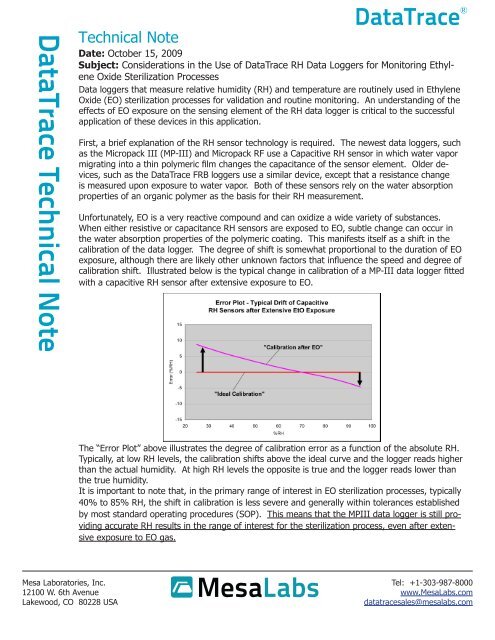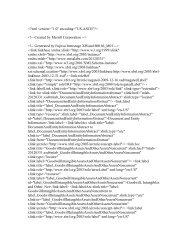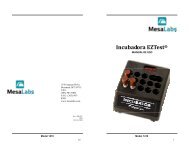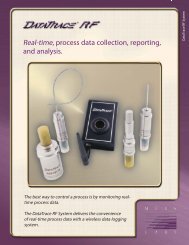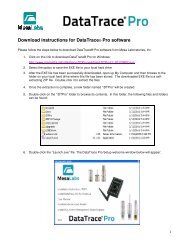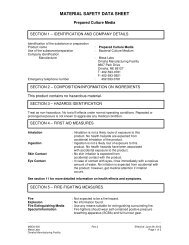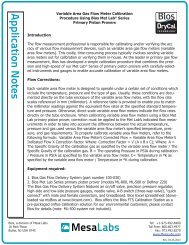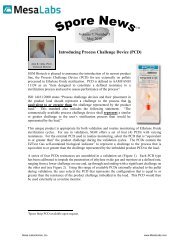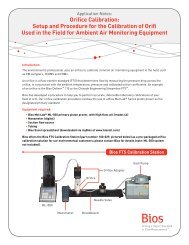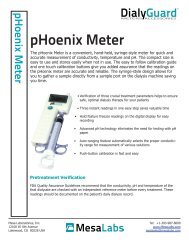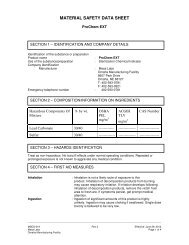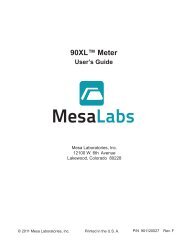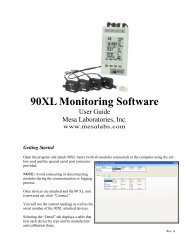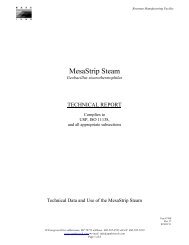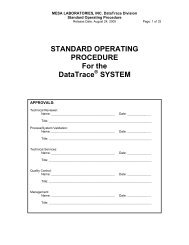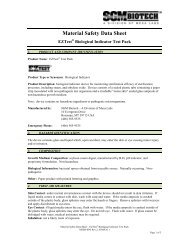The Use of Humidity Loggers in Ethylene Oxide - Mesa Labs
The Use of Humidity Loggers in Ethylene Oxide - Mesa Labs
The Use of Humidity Loggers in Ethylene Oxide - Mesa Labs
Create successful ePaper yourself
Turn your PDF publications into a flip-book with our unique Google optimized e-Paper software.
DataTrace Technical Note<br />
DataTrace ®<br />
Technical Note<br />
Date: October 15, 2009<br />
Subject: Considerations <strong>in</strong> the <strong>Use</strong> <strong>of</strong> DataTrace RH Data <strong>Loggers</strong> for Monitor<strong>in</strong>g <strong>Ethylene</strong><br />
<strong>Oxide</strong> Sterilization Processes<br />
Data loggers that measure relative humidity (RH) and temperature are rout<strong>in</strong>ely used <strong>in</strong> <strong>Ethylene</strong><br />
<strong>Oxide</strong> (EO) sterilization processes for validation and rout<strong>in</strong>e monitor<strong>in</strong>g. An understand<strong>in</strong>g <strong>of</strong> the<br />
effects <strong>of</strong> EO exposure on the sens<strong>in</strong>g element <strong>of</strong> the RH data logger is critical to the successful<br />
application <strong>of</strong> these devices <strong>in</strong> this application.<br />
First, a brief explanation <strong>of</strong> the RH sensor technology is required. <strong>The</strong> newest data loggers, such<br />
as the Micropack III (MP-III) and Micropack RF use a Capacitive RH sensor <strong>in</strong> which water vapor<br />
migrat<strong>in</strong>g <strong>in</strong>to a th<strong>in</strong> polymeric film changes the capacitance <strong>of</strong> the sensor element. Older devices,<br />
such as the DataTrace FRB loggers use a similar device, except that a resistance change<br />
is measured upon exposure to water vapor. Both <strong>of</strong> these sensors rely on the water absorption<br />
properties <strong>of</strong> an organic polymer as the basis for their RH measurement.<br />
Unfortunately, EO is a very reactive compound and can oxidize a wide variety <strong>of</strong> substances.<br />
When either resistive or capacitance RH sensors are exposed to EO, subtle change can occur <strong>in</strong><br />
the water absorption properties <strong>of</strong> the polymeric coat<strong>in</strong>g. This manifests itself as a shift <strong>in</strong> the<br />
calibration <strong>of</strong> the data logger. <strong>The</strong> degree <strong>of</strong> shift is somewhat proportional to the duration <strong>of</strong> EO<br />
exposure, although there are likely other unknown factors that <strong>in</strong>fluence the speed and degree <strong>of</strong><br />
calibration shift. Illustrated below is the typical change <strong>in</strong> calibration <strong>of</strong> a MP-III data logger fitted<br />
with a capacitive RH sensor after extensive exposure to EO.<br />
<strong>The</strong> “Error Plot” above illustrates the degree <strong>of</strong> calibration error as a function <strong>of</strong> the absolute RH.<br />
Typically, at low RH levels, the calibration shifts above the ideal curve and the logger reads higher<br />
than the actual humidity. At high RH levels the opposite is true and the logger reads lower than<br />
the true humidity.<br />
It is important to note that, <strong>in</strong> the primary range <strong>of</strong> <strong>in</strong>terest <strong>in</strong> EO sterilization processes, typically<br />
40% to 85% RH, the shift <strong>in</strong> calibration is less severe and generally with<strong>in</strong> tolerances established<br />
by most standard operat<strong>in</strong>g procedures (SOP). This means that the MPIII data logger is still provid<strong>in</strong>g<br />
accurate RH results <strong>in</strong> the range <strong>of</strong> <strong>in</strong>terest for the sterilization process, even after extensive<br />
exposure to EO gas.<br />
<strong>Mesa</strong> Laboratories, Inc.<br />
12100 W. 6th Avenue<br />
Lakewood, CO 80228 USA<br />
<strong>Mesa</strong><strong>Labs</strong><br />
Tel: +1-303-987-8000<br />
www.<strong>Mesa</strong><strong>Labs</strong>.com<br />
datatracesales@mesalabs.com
DataTrace Technical Note<br />
<strong>The</strong>re are several considerations and recommendations that can be made based on the<br />
behavior <strong>of</strong> RH data loggers exposed to EO, as follows:<br />
• To successfully utilize data loggers for monitor<strong>in</strong>g EO processes, it is important to rout<strong>in</strong>ely<br />
monitor their accuracy through periodic calibration checks. <strong>The</strong> duration between calibration<br />
checks depends on usage, but generally is between 3 months and 12 months. It is always safest<br />
to start at 3 months and only extend the time between checks after a history <strong>of</strong> stability is<br />
established.<br />
• It is important only that the calibration is accurate between the RH levels <strong>of</strong> <strong>in</strong>terest <strong>in</strong> EO<br />
sterilization (typically 40% to 85%). Inaccuracies outside <strong>of</strong> the area <strong>of</strong> <strong>in</strong>terest are generally<br />
not important and can be ignored.<br />
• When evaluat<strong>in</strong>g calibration accuracy, use an acceptance criteria established by standard EO<br />
protocols at your facility. Even though the loggers are calibrated to an accuracy <strong>of</strong> +/- 2% RH<br />
at the factory, it is unlikely that they will ma<strong>in</strong>ta<strong>in</strong> this accuracy follow<strong>in</strong>g EO exposure. An accuracy<br />
specification <strong>of</strong> between +/- 5% and +/- 10% is more appropriate for RH sensors that<br />
have been exposed to EO.<br />
• For the best accuracy, perform a calibration check at the typical EO sterilization temperature<br />
<strong>of</strong> approximately 55 C. <strong>The</strong> drift <strong>in</strong> calibration is less severe at 55 C than it<br />
o<br />
o<br />
o<br />
is at 25 C, where many data loggers are checked and calibrated.<br />
• <strong>The</strong>re are a number <strong>of</strong> RH calibration chambers available on the market for check<strong>in</strong>g<br />
the accuracy <strong>of</strong> data loggers. While salt solutions can sometimes be used successfully,<br />
they are somewhat cumbersome and prone to errors. Alternately, the data loggers can<br />
be returned to the factory for calibration checks.<br />
• If loggers are found to be out <strong>of</strong> calibration <strong>in</strong> the range <strong>of</strong> <strong>in</strong>terest, they can be recalibrated<br />
us<strong>in</strong>g the DataTrace s<strong>of</strong>tware. To successfully perform recalibrations, choose<br />
2 po<strong>in</strong>ts that span the range <strong>of</strong> <strong>in</strong>terest (i.e. 40% and 85%) and follow the <strong>in</strong>structions<br />
<strong>in</strong> the DataTrace SOP which can be found onl<strong>in</strong>e at www.mesalabs.com/datatrace-documents-and-downloads/<br />
• It has been noted that calibration <strong>in</strong>accuracies have a tendency to “self-correct” if the<br />
data loggers are outside <strong>of</strong> the EO environment for a period <strong>of</strong> time (1-2 days). It is<br />
a good idea to let loggers sit for this period <strong>of</strong> time prior to perform<strong>in</strong>g a calibration<br />
o<br />
check. Elevated temperatures (60 C) may help the loggers return to a calibrated state<br />
more rapidly.<br />
• <strong>The</strong> Resistive Sensor used <strong>in</strong> the older Micropack FRB loggers undergoes a shift <strong>in</strong><br />
calibration that is more severe <strong>in</strong> the mid-RH range, less predictable, and non-l<strong>in</strong>ear <strong>in</strong><br />
nature. More frequent calibration checks are generally called for if these older loggers<br />
are used.<br />
• Most RH sensors are adversely affected if liquid water forms on their surface. Under<br />
these “condens<strong>in</strong>g” conditions a shift <strong>in</strong> calibration can occur. EO process cycles should<br />
be designed, and loggers should be placed <strong>in</strong> the chamber, to avoid the possibility <strong>of</strong><br />
water condens<strong>in</strong>g on the logger.<br />
<strong>Mesa</strong> Laboratories stands ready to assist its customers <strong>in</strong> develop<strong>in</strong>g an effective quality<br />
control program for their RH data loggers. We can recommend the type <strong>of</strong> equipment<br />
required to perform calibration checks, or we can perform these checks <strong>in</strong> our calibration<br />
laboratory. Simply contact your sales representative or the factory directly for assistance<br />
with this or any other data logger application.<br />
<strong>Mesa</strong> Laboratories, Inc.<br />
12100 W. 6th Avenue<br />
Lakewood, CO 80228 USA<br />
<strong>Mesa</strong><strong>Labs</strong><br />
Tel: +1-303-987-8000<br />
www.<strong>Mesa</strong><strong>Labs</strong>.com<br />
datatracesales@mesalabs.com


